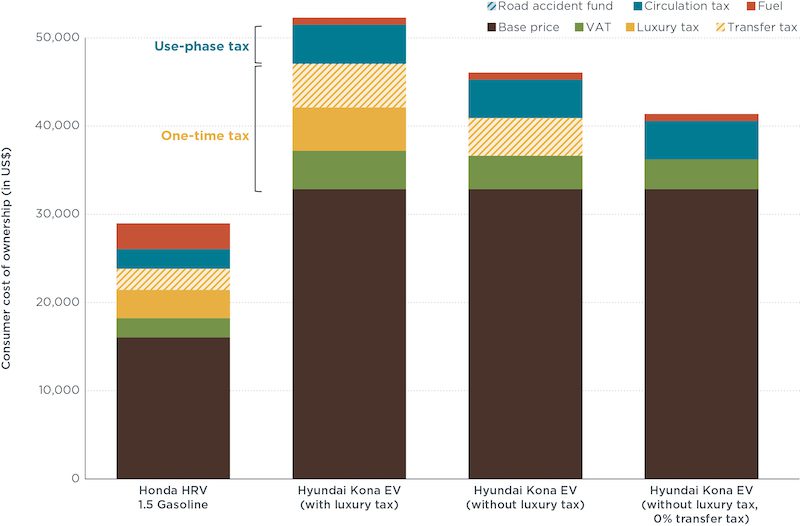The consumer cost of ownership of electric passenger cars in Indonesia
Blog
Will Indonesia’s ambitious plan to subsidize EVs and hybrids benefit everyone?
In December 2022, Indonesia’s Minister of Industry, Agus Gumiwang, announced the government’s plan to provide purchase subsidies for electric cars, hybrid cars, and electric motorbikes, and to subsidize the cost of converting combustion-engine motorbikes to electric. Under the scheme, a subsidy of IDR 80,000,000 (~US$ 5,130) will be given for purchasing a new battery-electric vehicle and half that amount for purchasing a conventional hybrid. New electric motorbikes will receive a purchase subsidy of IDR 8,000,000 (~US$ 520), and the government will pay IDR 5,000,000 (~US$ 320) for converting an ICE two-wheeler to an electric two-wheeler.
Before announcing the subsidy, the Government of Indonesia studied similar policies in other countries to evaluate their effectiveness in spurring demand for electric vehicles. ICCT’s studies of policies to accelerate EV adoption in global markets tend to support incentive plans. For example, China adopted a very structured monetary incentive program for passenger cars, buses, and trucks that linked the value of the incentive to battery chemistry and capacity. France, the Netherlands, and the U.S. also offer monetary incentives to EV customers.
The Indonesian government’s main interest in offering these subsidies is developing domestic EV manufacturing and related supply chains. Electrification of the transport sector can also ease the cost burden of fuel subsidies. In addition, this transition to EVs can help ensure that national net-zero emissions can be achieved by 2060, the target date set by the government.
Transport decarbonization requires a comprehensive approach that facilitates access to battery electric technology not only for private owners but also for public transit operators and users. Fortunately, Indonesian President Joko Widodo recently announced subsidies for electric public transport vehicles that are produced domestically or meet minimum local content requirements. The magnitude of the incentives for battery electric bus purchases has not been made public.
These incentives are designed to close the purchase price gap between EVs and conventional vehicles. However, the cost of owning and operating a vehicle includes a wider range of factors that affect this value, including taxes.
We recently published a paper examining the impact of taxation on the consumer cost of EVs and internal combustion engine (ICE) vehicles in Indonesia. We show there that cost parity between two popular vehicles belonging to the same market segment, the Hyundai Kona EV and the Honda HR-V, cannot be achieved within six years of ownership with the existing taxation system in Indonesia. This is because the base price of the Hyundai Kona EV is higher. and incentives such as luxury tax and transfer tax exemptions alone cannot sufficiently reduce the upfront cost differential. The chart below illustrates this.

Figure. Consumer cost of ownership for Honda HRV and Hyundai Kona EV with taxation levels
Even the generous direct incentives proposed by the government are insufficient to close the price gap between conventional and electric vehicles. The showroom price for a Hyundai Kona EV in Jakarta is ~US$ 51,000, while the price for the comparable Honda HR-V is ~US$ 26,500. The proposed subsidy of ~US$ 5,130 will lower the EV price by 10 percent but will only close about one-fifth of the purchase price gap.
Our analysis shows that to close the consumer cost of ownership gap between electric and conventional vehicles, additional actions are required on top of generous monetary incentives and the current tax reductions for EVs. A purchase subsidy to help lower the upfront cost of EVs could work better if paired with mandatory fuel efficiency or CO2 emission standards. Passenger vehicle fuel efficiency or CO2 emissions standards drive technology innovation and position the battery electric option as a viable solution to meet the standards.
Instead of direct purchase subsidies for EVs and hybrids, it could be even more effective for the government to introduce a feebate program and structure it based on fuel consumption or CO2 emission levels. In such a program, the least-efficient vehicles or those with the highest CO2 emissions (for example, SUVs) are taxed most heavily, and financial rebates are given for the most-efficient models, especially EVs. This type of program can be designed to be revenue neutral: highly polluting vehicles, which tend to be purchased by wealthy individuals, pay for the incentives to zero-emission and low-polluting vehicles. Because of the revenue-neutral nature of these programs, they can be run for many years, which addresses the challenge of direct monetary subsidy schemes.
Limiting the subsidy to vehicles below a certain price cap (e.g., US$ 50,000) and allocating more subsidies for electric two-wheeler and electric public transport would also improve the effectiveness in reducing carbon emissions from transportation.
Indonesia is the second-largest automotive producer in the Southeast Asian region, behind only Thailand, with 900,000 passenger vehicles produced in 2021. The plan to provide purchase subsidies for EVs and hybrids is ambitious and will likely contribute to the growth of EV production in the country. With its large nickel deposits, Indonesia could be an important player in the global EV supply chain if it nurtures its domestic EV industries.
The transition to electric vehicles can positively impact Indonesia’s future carbon emissions and help it achieve its industrial development goals. The plan to subsidize electric vehicles for both private and public transit users aligns with global practices on EV policy but may not be able to deliver the best results without other policies targeting fuel efficiency or CO2 emission standards and feebates.
